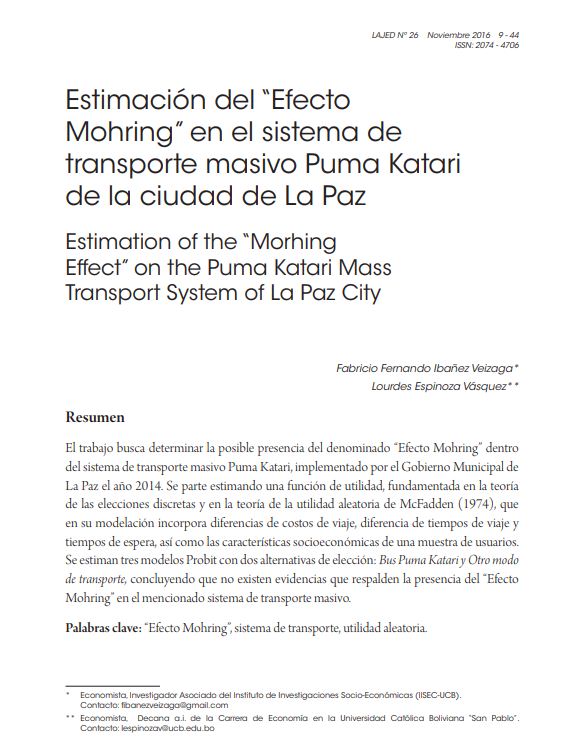Estimation of the “Morhing Effect” on the Puma Katari Mass Transport System of La Paz City
DOI:
https://doi.org/10.35319/lajed.20162656Keywords:
Mohring Effect, Transport System, Random UtilityAbstract
The current document attempts to establish the possible presence of the “Mohring Effect” on the Puma Katari mass transport system created by the Municipal Government of La Paz on 2014. It begins estimating the utility function, as established on the theory of discreet elections and McFadden’s theory of random utility (1974), which incorporates differences on the trip costs, times and wait times as well as the socioeconomical characteristics of an user group. As a result, three Probit models are estimated with two alternatives: Puma Katari Bus and Other transport mode, concluding that there are no evidences that support the presence of the “Mohring Effect” on said massive transport system.
Downloads
References
Basso, L.J. y S.R. Jara-Díaz. 2010. “The Case for Subsidisation of Urban Public Transport and the Mohring Effect”. Journal of Transport Economics and Policy, 44(3), 365-372.
Bates, J. y M. Roberts. 1986. “Value of time research: summary of methodology and findings”. American Economic Review, 97(2)
Becker, G. 1965. “A theory of the allocation of time”. American Economic Review, 52, 591- 604.
Betancor, Ofelia y Gustavo Nombela. 2002. “Mohring effects for air transport”. EIETUniversity of Las Palmas, Spain.
Collect-Gf K. 2010. Transantiago: Estudio Tracking Calidad de Servicio N°3, AgostoSeptiembre.
De Rus, Ginés, Javier Campos y Gustavo Nombela. 2004. Economía del transporte. Universidad de Las Palmas de Gran Canaria.
De Serpa, A. 1971. “A theory of the economics of time”. American Economic Review, 99(3).
Gómez-Lobo, A. 2011. Monopoly, Subsidies and the Mohring Effect: A synthesis and an extension. Universidad de Chile, SDT 336
INE. 2009. “Informe estadístico sector del transporte”.
Islas Rivera, Víctor M., César Rivera Trujillo y Guillermo Torres Vargas. 2002. “Estudio de la demanda de transporte”. Publicación técnica N° 205, Sanfandila. Instituto Mexicano del Transporte.
Jansson, Jan Owen. 2001. “The Mohring Effect in Interurban Rail Transport: Case Study of the Swedish Railways”. Competitive and Sustainable Growth Programme.
Jansson, K. 1993. “Optimal Public Transport Price and Service Frequency”. Journal of Transport Economics and Policy, 27, 33-50.
Jara-Díaz, S.R. y A. Gschwender. 2009. “The Effect of Financial Constraints on the Optimal Design of Public Transport Services”. Transportation, 36(1)65-75.
Jara-Díaz, S.R. y M. Farah. 1987. “Transport demand and user´s benefits with fixed income: the goods/leisure trade-off ”. American Economic Review, 98(2) 39 Fabricio Fernando Ibañez Veizaga y Lourdes Espinoza Vásquez
Karamychev, V. y P. Van Reeven. 2010. “Oversupply or Undersupply in a Public Transport Monopoly? A rejoinder and Generalization”. Journal of Transport Economics and Policy, 44(3), 381-89.
McFadden, D. y K. Train. 2000. “Mixed MNL Models of discrete choice response”. Journal of Transport Economics and Policy, 80(3), 365-380.
Mohring, H. 1972. “Optimization and Scale Economies in Urban Bus Transportation”. American Economic Review, 62, 591-604.
Moreno Quintero, Eric. 2011. “Métodos de elección discreta en la estimación de la demanda de transporte”. Publicación técnica N° 335 Sanfandila. Instituto Mexicano del Transporte.
Parry, Ian W. H. y Kenneth A. Small. 2009. “Should Urban Transit Subsidies Be Reduced?” American Economic Review, 99(3), 700-724, June.
SETRAM. 2014. “Evaluación del servicio primeros 45 días”, marzo de 2014.
SETRAM. 2014. “Revista informativa de rutas y avances tecnológicos previstas para el año 2015”, agosto de 2014.
Spence, A. M. 1975. Monopoly, Quality, and Regulation. Bell Journal of Economics, 6(2), 417-429.
Van Reeven, P. 2008. “Subsidisation of Urban Public Transport and the Mohring Effect”. Journal of Transport Economics and Policy, 42(2), 349-59.






